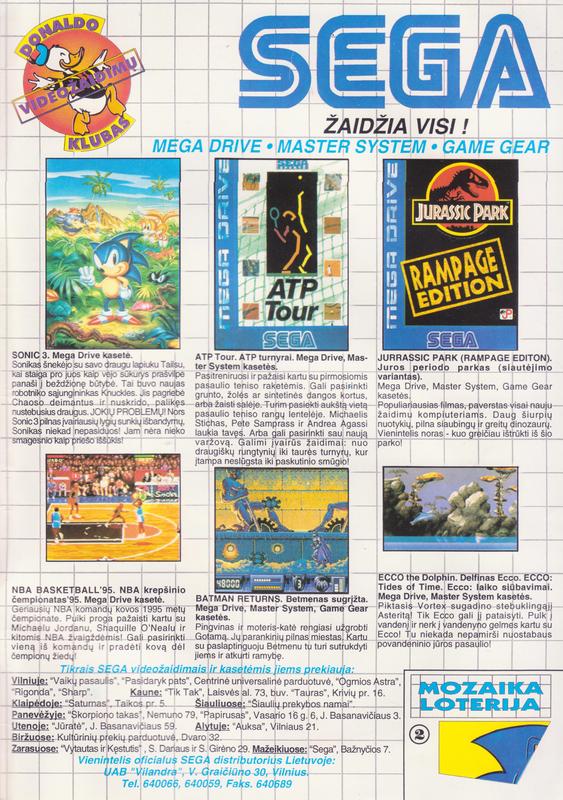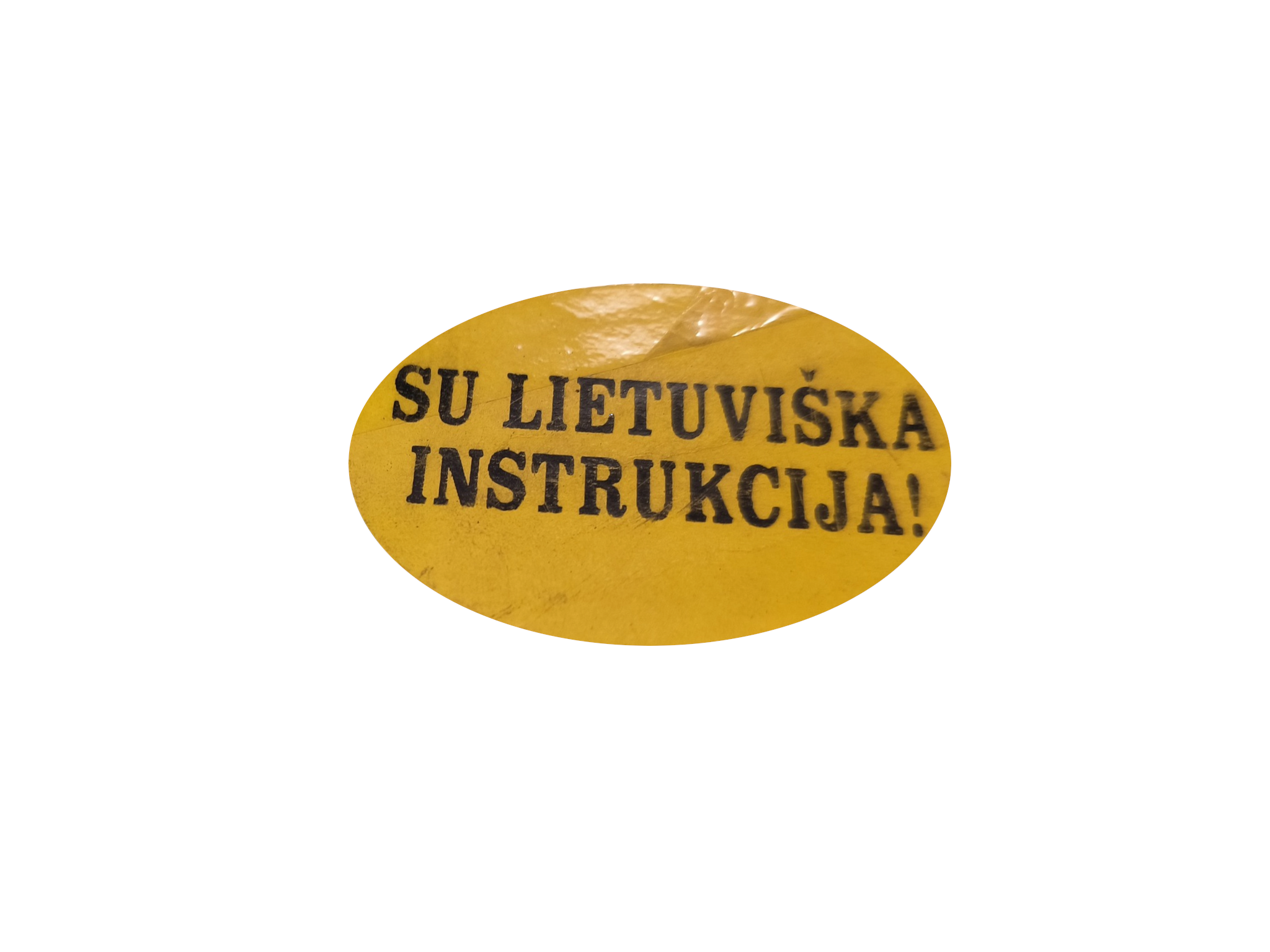History of Sega in Lithuania
From Sega Retro

|
| History of Sega in Lithuania |
|---|
| Official Sega distributor(s): Vilandra (1995-1998), Andrico (2008-2013), Gamelab (2009-2013), TKM Baltics (2014-2019), iWare Distribution (2019-present) |
This short article is in need of work. You can help Sega Retro by adding to it.
In March 11, 1990 Lithuania declared independence from the USSR and became an independent state. For foreign companies such as Sega, this meant a new market must be obtained.
Contents
Zhiliton
Back in the days of the Soviet Union, Sega tried to enter the market with the special model of first Master System (SECAM signal, lack of card slot and Alex Kidd in Miracle World built in) through Beryozka stores selling luxury goods, but the lack of good advertising, a small distribution network and the luxurious nature of the system resulted in failure.
From early 90s, Rambo TV Game, a Atari 2600 clone, was released and became the first more known console, that was quickly replaced by Zhiliton 938-A, a clone of the Nintendo Famicom, designed to resemble Sega Mega Drive, which found success across all Baltic States. However, no one suspected that the console was similar to Sega's products due to their lack in the region.
It is also known that the Dendy console, popular in other USSR countries appeared in this region by Steepler resellers. The Dendy received some attention, but was never as popular as Zhiliton, especially with more and more new and cheap clones on the market such as UFO, Liko, Terminator 2 and Subor. Later Steepler distributed here Mega Drive clones like Pro 16 Bit, High Quality and also some original Asian Mega Drive 2 and US Genesis CDX with original NTSC-U, PAL Asia and bootleg games. In November 1994, Steepler was licensed by Nintendo to sell their products in all former Soviet Union countries, and thus Super Nintendo and Game Boy were released in that region, but these products were not popular.[1]
Vilandra
The first official consoles were released in early 1995 by Vilandra, selected as representative of Sega in the region. The company created a distribution network across the country and began selling Sega Mega Drive model II[2], Sega Master System[3] model II and Sega Game Gear[4]. One of the first promotion event was a trip to Disneyland and every console had lottery card in it. In children's magazines such as Mickey Mouse and Genys appeared sponsored articles about Sega games and consoles as well as a lottery with prizes. In autumn 1995, Sega Mega-CD II[5] and Mega Drive 32X were released. In the same time, they started to add translated manuals to some of the titles such as Mega Games I (MD), Skeleton Krew (MD), Sonic & Knuckles (MD), Sonic the Hedgehog (MD, MS)[6] and others.
From December 1995, the focus was on the Sega Saturn[7] promotion, which could also be won in some children's magazines. Due to very high price, Saturn's situation wasn't very good and only 100 units were sold throughout the year so the price dropped from 2,999 litai to 1,499 litai. Consequently, the games were also not quite popular. Sega Rally had sold 60 units until November 1996, and for example NBA Action, released in Lithuania in mid-October 1996, had been bought by mid-November 1996 in 10 units[8]. Of course, promotions were organized, such as during the Christmas 1996, where for buying two games for Sega Saturn people could get a Christmas Nights or a watch for free.[9]In 1997, apart from winning consoles, there was a trip to Sega World to win.
As in other countries of the former Eastern bloc, game piracy has also hit Lithuania. The clones of Mega Drive cost 400 litai in 1995, and in next years prices were dropped to 200 litai.[10]Original console cost from 800 to 1200 litai in 1995[11], and prices were also dropped in next year to 569 litai[12]. According to Vilandra, in every month of 1996, about 10 counterfeit Mega Drives were delivered to the company's service for repair, which could not be repaired due to the lack of warranty on the clones.[13]Dariaus Laurinavičiaus, the manager of Vilandra, said that counterfeit games cost from 70 litai to 150 litai, while the original ones from 100 litai to 300 litai. In order to encourage people to buy originals, the distributor organized a promotion in which buyers of cartridges receive free watches (worth about 80 litai) with images of characters from Sonic and Knuckles game. This was to cover the difference in the purchase.[14]
Unfortunately, in 1998 due to poor sales of Saturn, Vilandra withdrew from further distribution. Mega Drive with Famiclones and PlayStation still remains in this region as one of the most popular consoles from the 90s. Besides Famicom and Mega Drive clones, Sega had competition in form of Super Nintendo and Game Boy (distributed from November 1994 by Steepler[15]), Atari Jaguar (distributed from 1995 by Game Land), PlayStation (distributed from April 1997 by Computer 2000[16]) and 3DO.
also published in:Expand
Dreamcast
Between late 90s/early 2000s, Famicom and Mega Drive clones were still popular in Lithuania. Local retailers sold Zhiliton clones for less than 50 litai and 16-bit Sega for less than 100 litai.[18]
Sega Dreamcast reached Lithuania in 2000 and was sold by few local distributors. It was usually seen in game centers where people could play a certain amount of time in exchange for money[19].
Andrico/Gamelab
In 2008 Andrico became a distributor.[20] In 2009, the company made an agreement with Gamelab regarding the sale of games in the region of the Baltic states.[21]Andrico helped Gamelab and translated the game boxes into Lithuanian. The cooperation ended in 2013.
Several publishers from Russia have also released Sega games in this country. 1C-SoftClub sold, among others, Sonic All-Stars Racing Transformed and Football Manager 2011. Akella released Sakura Taisen in the Baltic States. There were also many pirate games on PC from Russia.
TKM Baltics and iWare Distribution
From 2014 to 2019, the Latvian company TKM Baltics became the distributor of Sega games in this region. The games were mainly available for purchase on the Gamebalt website.[22]
iWare Distribution became a distributor in 2019.
To this day, clones of Mega Drive can still be found on the market. There are mainly from Russia but some of them originate directly from Asia. However, these clones are not very common and are not as popular as they were in the 1990s.
References
- ↑ https://www.kommersant.ru/doc/94004
- ↑ Sega Mega Drive II- Mickey Mouse "6/1995"
- ↑ Mickey Mouse "5/1995"
- ↑ Demesio! Naujiena! Sega Game Gear- Mickey Mouse "7/1995"
- ↑ Sega Mega CD II- Mickey Mouse "10/1995"
- ↑ Mickey Mouse (LT) #35: "1/1996" Puiki naujiena Sega gerbejams!
- ↑ Mickey Mouse (LT) #34: "12/1995" Sega Saturn
- ↑ https://www.vz.lt/archive/news.php/id=388558
- ↑ https://www.vz.lt/archive/news.php/id=408417
- ↑ https://tauragesmuziejus.lt/istorija/taurages-kompiuterines-90-uju-reiskinys/
- ↑ https://tauragesmuziejus.lt/taurages-kompiuterines-90-uju-reiskinys/
- ↑ https://www.vz.lt/archive/news.php/id=388558
- ↑ https://www.vz.lt/archive/news.php/id=388558
- ↑ https://www.vz.lt/archive/news.php/id=408417
- ↑ https://www.kommersant.ru/doc/94004
- ↑ http://web.archive.org/web/19980703064424/http://www.playstation-europe.com/playstation/pr/launch.htm
- ↑ Kiber Zona, "Birzelis 1997" (LT; 1997-xx-xx), page 5
- ↑ https://web.archive.org/web/20021003095506/http://www.baitukas.lt/zaidimu_konsoles.php
- ↑ https://tauragesmuziejus.lt/istorija/taurages-kompiuterines-90-uju-reiskinys/
- ↑ https://web.archive.org/web/20081216013038/http://www.andrico.ee:80/pood/conditions.php
- ↑ https://web.archive.org/web/20110912222305/http://www.gamelab.ee:80/
- ↑ https://web.archive.org/web/20170625073149/http://www.sega.com/sega-approved-partner-list







